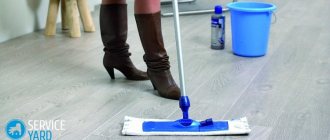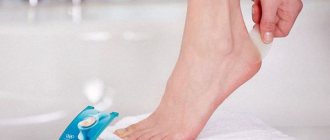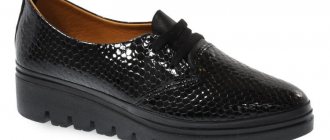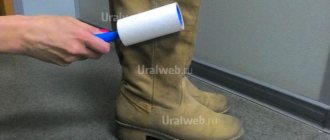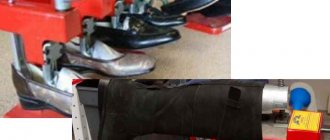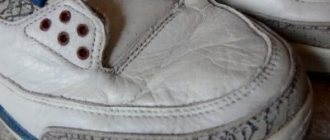Calluses are an unpleasant occurrence for feet. Carrying out daily chores around the house becomes painful, and wearing your favorite shoes becomes impossible. Feet are the most susceptible to calluses due to the daily pressure placed on them while walking or running. Calluses form as the body's natural defense against external irritants. How to prevent them from appearing?
Reasons why shoes rub
Calluses are painful bumps that occur when the top layer of skin pulls away from the underlying layers and fills with fluid. Walking in shoes that don't fit properly or are made of poor quality material can harm your feet.
The main reasons why shoes rub:
- Wrong size. Choosing the wrong size can have a number of negative health consequences. If shoes are too narrow, tight or loose, blisters or sores may occur, which are very slow to heal and lead to infections. In addition, older people's feet become larger and wider because of this, but they often continue to buy the same size. Poorly fitting shoes can also contribute to headaches and back pain.
- Rough material. Making shoes from recycled materials is a trend that shoe factories have been following lately. In the past, companies were environmentally responsible. From evening shoes to casual sneakers and boots, low-quality items made from recycled materials are slowly filling the market.
- Inappropriate model. Any shoes should fit perfectly on the foot, not squeeze it or cause discomfort. For example, shoes that fit properly but are too small or too wide are considered an unsuitable model. When choosing, you need to pay attention to the block.
- Swelling of the feet. Blood can pool in the veins of the legs and feet, causing swelling. Swelling of the feet actually increases the size of the leg. Therefore, shoes that fit properly will rub. In addition, swelling can be caused directly by inappropriate size.
On the soles of the feet, calluses usually develop near the base of the toes.
Is it possible to return (change, return)?
According to the current legislation of the Russian Federation, two types of guarantee apply to purchased shoes:
- Exchange guarantee;
- Quality assurance.
This is interesting: Is it possible to wash suede shoes in a machine, how to wash them with soap
In the first case, this means that within 14 days from the date of purchase you can contact the store and ask to exchange the product for a more suitable one. Possibly with an additional charge. This can be done if the product does not fit you in size, you are not satisfied with the shape, style, color, or the package is incomplete.
Important! In addition to the product itself, you need to have its packaging and a receipt confirming the fact of purchasing the shoes. In addition, all factory tags must remain intact.
The quality guarantee implies that the customer can return a product that has been found to have a manufacturing defect. In this case, an examination is appointed, during which the causes of the defect are determined. If it really is the manufacturer's fault:
- The consumer is provided with another pair of shoes, but of appropriate quality;
- Or repairs are carried out free of charge.
The seller has 20 days for this.
After the specified period, in the absence of any action on his part, the buyer has the right to a refund.
You can take advantage of this opportunity if you suddenly discover after the purchase that:
- Paint is falling off shoes;
- The sole has come off or worn out (if the shoes have been worn for no more than 3 months);
- The seams are broken.
Attention! Only shoes that have retained their salable condition are accepted for return, repair or exchange.
You will not be able to use the guarantee if you:
- The shoes were damaged in the process of self-repair (only replacing the heels and gluing a preventive outsole is allowed if this does not result in defects);
- The product was worn in conditions not intended for this purpose (out of season);
- The product was accidentally damaged in some other way during use.
Therefore, try to handle the product as carefully as possible until you finally understand whether it suits you. Otherwise, all you can do is give it as a gift to someone or resell it.
Shoemaker tips
In order to avoid all sorts of problems associated with rubbing shoes, follow a few simple recommendations when choosing them:
- Don’t rush to buy the first pair you come across, even if, at first glance, it fits your feet perfectly. Walk around the store in it for a couple of minutes. Sometimes the feeling of discomfort does not appear immediately;
- You shouldn't buy a smaller model than you need just because it looks more attractive. During wear, the shoes will still not stretch to the size you need, but problems with the health of your feet are guaranteed to make themselves felt;
- Buying shoes that are more spacious than necessary is not protection against chafing. The material will also come into contact with the skin in unnecessary places, causing pain;
- Pay attention to the quality of tailoring. On the inner surface of the shoe there may be protruding pieces of fabric, seams and other unnoticeable details that will make themselves felt during your first walk. If you find them, it is better to refuse to buy a pair, despite its visual appeal;
- The best choice is products made from natural fabrics or leather with high-quality orthopedic lasts. They fit the leg well, leaving enough free space for comfortable wearing, and do not interfere with the access of oxygen. In addition, such materials stretch more easily, changing their shape if necessary and adapting to the physiological characteristics of your foot.
This is interesting: Time-tested shoe care products: Salamander, Sapphire, Ecco, Riker or prefer new items
Remember that preventing the appearance of calluses is easier and better than getting rid of them later. And care when buying shoes is the first thing that is necessary for this.
What to do if your shoes rub
How to soften shoes made of natural and artificial leather
There are three ways to make your skin softer:
- using oil;
- using alcohol and Vaseline;
- distribute.
Softening with oil
First you need to clean the surface of the shoes with a damp cloth or sponge. Then wipe with a dry cloth and make sure they are completely dry and ready to apply the product.
- Pour some oil into a small, clean bowl. Wrap two fingers in a clean cloth, dip them in the oil and let the excess drip off. Then apply to shoes.
- Rub the oil in with gentle circular movements.
- After applying one layer, allow it to completely absorb into the material. Depending on your skin type, it may take a few hours or a full day before applying another layer.
- As the oil is absorbed, you need to evaluate the softness of the skin. You can reapply the product as needed.
The oil restores and nourishes natural and artificial leather, making it softer. Mink, coconut, foot oil and saddle soap can be used to soften leather shoes. You need to beware of products that contain pine resin, castor oil, mineral oils and other toxic chemicals.
Using alcohol and Vaseline
This is the easiest and most cost-effective method, since both components are easy to find in the store. The amount of product depends on the model. For example, for high boots, you will need more Vaseline.
- Soak a cotton swab in alcohol, then wipe the entire surface of the shoe. Remove laces, if present, to finish the tongue and inner side. Allow the product to dry for thirty minutes.
- Apply Vaseline using the same principle. You can use an old toothbrush. Apply the product in a thin layer. Then you need to leave the Vaseline to soak in overnight. After the skin has softened, wipe it with a dry cloth to remove excess product. If the skin is not soft enough, the procedure is repeated again. Sometimes several coats are required to achieve the desired level of softness.
Breaking in shoes
An effective way to soften leather is to wear it on. Repeated wearing of leather shoes or boots will make them more pliable. However, if you wear a new pair all day, there is a risk of swelling and calluses. To minimize the consequences, you need to wear shoes for several hours and then change to more comfortable ones. Once your new pair becomes softer, you can wear them all day.
What products have you tried to stretch your shoes?
Professional
Homemade
What to do with textiles
- Vinegar. Acid has a softening effect on textile fabric, so it can also be used as a stretcher. Just soak the cloth in vinegar and put it in your shoes, leave it like that until the morning. The only side effect of this method is that the vinegar will leave an odor in the shoes, but this can be easily removed by leaving the shoes outdoors for a day.
- Wet newspaper. Moisten the newspaper with water and place it inside the shoe so as not to deform its shape. Leave it in this state for several hours and then remove the newspaper. This will certainly help expand the textile shoe and adjust it to your foot size.
- Wet warm rag. Using high temperature can soften textiles. You need to soak a rag in hot water, let it cool for 5 minutes and put it inside the shoes. As soon as the rag is dry, you need to take it out and put on your shoes with warm socks.
Special means
Stretching tight shoes using improvised means is cheap and convenient. However, with this approach there is always a risk of ruining expensive shoes. Today, to solve the problem, special sprays and stretching foams have been developed, which are simple and safe to use.
Sprays
Basically, the rules for working with sprays from different manufacturers are the same: the composition is sprayed inside and outside the shoe, the shoes are put on the foot (preferably on a nylon or cotton sock) and worn in for half an hour. You shouldn’t expect the product to increase much in length, but the sides and nose will become much softer, and you won’t have to rub your feet with shoes again. The effect of using industrial stretch marks becomes noticeable after several treatments.
Here are a few products that have received positive customer reviews:
- Salamander Shoe Stretch - for genuine leather and suede;
- Pregrada - for all skin types;
- Damavik - for artificial and natural leather, suede;
- TWIST - for leather, suede, velor, nubuck;
- SALTON - for smooth leather, suede, patent leather, nubuck.
We recommend: How to clean a coffee machine from scale and coffee oils and how to rinse the cappuccino maker?
Protective strips
In shoe stores, along with a new pair, you can purchase protective strips and heel guards, which are glued inside the shoes for comfortable wearing. To accurately determine the location of the possible appearance of a callus, you need to remember your experience with previous shoes or sandals. Where they rubbed the most, a protective strip is glued there.
Anti-slip insoles
Insoles with anti-slip coating will help you adapt to shoes that are slightly larger than desired. Especially if the model is wearing high heels. Those whose feet sweat profusely cannot do without this device. The insoles absorb excess liquid, the foot remains dry and does not slip inside the sandal. On sale you can also find special lasts for stretching new shoes to the desired size.
You can buy a pencil against calluses at the pharmacy. It contains nourishing, emollient, and sometimes antiseptic components. Before going out in new shoes, the feet in those places where abrasions may appear are lubricated in advance with a pencil and save yourself from troubles for the whole day. Medifit and Compeed pencils have proven themselves to be the best.
What remedies help?
- Liquid for stretching. To stretch leather shoes, you need to put them on and apply the spray according to the directions on the package. Wear until the spray dries. In the process, the skin will adapt to the shape of the leg.
- Shoe stretchers. Shoe stretching pads. They are suitable for both men and women. Made from real beech wood.
- Ice. Fill two bags with water and tie. Place them inside the products and put them in the freezer. When the water turns into ice, you need to take it out so that it melts. Repeat the procedure several times until the shoes reach the desired size.
Tools for stretching tight shoes
Tight, uncomfortable shoes can be “fixed” at home. There are several proven methods for this.
- Vodka, alcohol.
Using vodka or alcohol you can soften the hard edges of shoes and boots. The main thing is to check the strength of the paint on an inconspicuous area before starting the procedure, since alcohol-containing substances can discolor materials.
A cotton pad is soaked in vodka and wiped over the inside of the shoe, paying special attention to the edges. When the material is thoroughly wet, knead it with your fingers, trying to make it softer. You can put on a pair and walk around the apartment a little, and if necessary, repeat the treatment the next day.
- Castor or sunflower oil, glycerin.
These substances have a softening effect, and have an equally positive effect on both shoes and the skin of the feet. Dip a cotton pad in oil or glycerin, treat the inner surface of the material, not missing the seams, and then knead it with your fingers. This procedure is useful not only for a new pair, but also for boots that have become rough after winter inactivity.
- Wax, soap.
If shoes rub your heels, lubricate the inside of the heels with hard soap or a candle. This reduces friction. The procedure is repeated until the pair is separated.
We recommend: In what cases does an electronic cigarette need cleaning and how to do it?
- Hammer.
Berts, boots, shoes and other shoes made of hard leather can be softened with a hammer. Place a piece of soft material on the problem area and, gently tapping, break it with a hammer. The method is not suitable for varnished models, as the glossy surface may crack.
- Beer.
An excellent means of softening suede shoes. The toe and heels are soaked in a foamy drink and then kneaded with your hands. When the result is achieved, the boots need to be cleaned and aired.
- Paper.
For work, it is better to take white, unpolished paper, although you can get by with newspapers. Lumps of damp paper are placed inside shoes or boots and left for a day until dry. You shouldn’t force things - put the problematic pair on the battery or take it out into a draft. The paper should take a long time to dry and be sure to dry completely.
- Water packs.
This method is based on the ability of water to expand when frozen. They fill small plastic bags with enough water to fit inside the model, and put the shoes in the freezer overnight. Freezing water will spread the tight last, and the shoes will become a little larger.
The easiest and safest way for shoes is to wrap the box with the problematic pair in a wet terry towel and leave it overnight. You will have to throw away the box, but the boots will become softer and will stop rubbing.
What can you do about calluses?
To get rid of calluses on your feet, you need to steam them well. Fill the bath with warm water, add salt, essential oils or tea. These substances soften the skin for the next stage - resurfacing. Using a pumice stone on your feet, you need to carefully remove the callus, removing dead skin. If the wound is particularly large, you should not try to remove it right away. After the procedure, it is advisable to moisturize your feet with cream.
Remedies that will help with calluses:
- For better results, you can use aloe vera. It contains salicylic acid and amino acids that soften hard skin cells. In addition, it has antibacterial, anti-inflammatory and healing properties.
- Castor oil is another ingredient that is well known for its softening and moisturizing properties. It can also stimulate the production of elastin and collagen, which provide skin elasticity. And vinegar will help exfoliate hard skin.
- Fine grain salt is another option for gently exfoliating your skin. Mix a tablespoon of table salt with a tablespoon of olive oil. Rub this mixture into hardened skin before bathing, then rinse with warm water.
- Flaxseed oil, which has emollient and anti-inflammatory properties, may be beneficial for calluses. Essential fatty acids of flax give this healing oil a softening, moisturizing and soothing effect. It is necessary to soak your feet in warm water and apply a cloth soaked in linseed oil to the callus. Wrap in film and leave overnight.
How to choose the right shoes so that they don’t rub
- Before purchasing, you need to measure your foot length to accurately select the size.
- When trying on, you need to make sure that you can move all your toes comfortably. The pair should not fit tightly on the leg; it is important to have additional space so that there is no discomfort when walking.
- Shoes should be comfortable. Therefore, you need to go through it before purchasing.
- You need to carefully examine the inside for various protrusions that may cause discomfort.
- Inspect the sole. Is it strong enough to protect against sharp objects such as glass and stones? It is advisable to walk on both carpet and hard surfaces during fitting.
Poor quality or incorrectly selected shoes cause discomfort when walking, resulting in calluses. You don't have to immediately return your new sneakers or shoes to the store. You can use the available tools to make your new pair comfortable.
